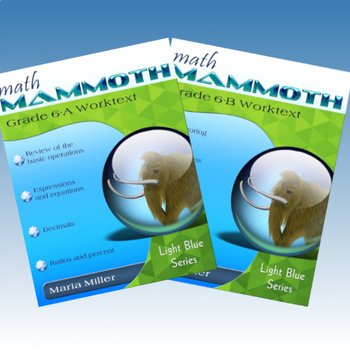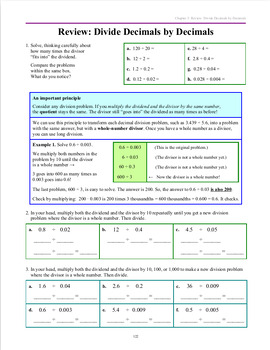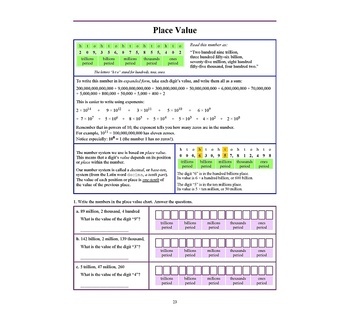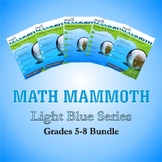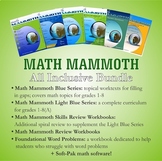Math Mammoth Grade 6 Complete Curriculum
- Zip
Also included in
- This bundle includes grades 5, 6, 7, and 8 from the Math Mammoth curriculum.Each grade level consists of two student worktexts (A and B; written directly to the student), answer keys, chapter tests, end-of-year test, additional cumulative reviews, and a versatile worksheet maker (Internet access reqPrice $112.50Original Price $167.00Save $54.50
- This BUNDLE OF BUNDLES contains these Math Mammoth products:Math Mammoth Blue series Math Mammoth Light Blue series Math Mammoth Skills Review workbooksMath Mammoth Review workbooks Math Mammoth Foundational Word Problems workbookPrice $280.00Original Price $592.45Save $312.45
Description
Math Mammoth Grade 6 Complete Curriculum is a complete math program for sixth grade, providing you with everything you need to teach sixth grade math. At the heart of the curriculum are two student worktexts (A and B), each with lessons covering about half a year of math work. These worktexts contain all the instruction and the exercises in the same book—which makes lesson preparation a breeze. The worktexts are written so the student can learn directly from the books.
You will also get separate answer keys, chapter tests, additional cumulative reviews (I do recommend you use at least some of them), and a versatile worksheet maker (Internet access required) for those times when the child needs just a bit more practice.
Math Mammoth focuses on conceptual understanding. It explains the "WHY", so the children can understand the math, not just learn "HOW" to do it. Concepts are often explained with visual models, followed by exercises using those models. These visual models can take the place of manipulatives for many children; however, it is very easy to add corresponding manipulatives to the lessons if you wish.
The curriculum is mastery-oriented. This means it concentrates at length on a topic, delving into its various aspects. This promotes conceptual understanding, as opposed to spiral curricula that tend to often jump from topic to topic.
It requires very little teacher preparation required. The curriculum has no separate teacher's manual nor is it scripted. The introduction to each chapter has some notes for the teacher concerning the material in the chapter. All the instruction is written directly for the student in the worktext, and there are also links to videos available to view Maria teaching the material.
After each chapter introduction, you will find a list of Internet links and resources (games, quizzes, animations, etc.) that can be used for fun, illustrations, and further practice.
BONUS! You will also get Soft-Pak programs completely FREE. The 6 programs in Soft-Pak (4 math, 1 language arts, 1 list maker) offer both on-screen and printable activities in a low-graphic, high content format.
Please also see the sample preview for the table of contents for 6-A and 6-B.
In sixth grade, students encounter the beginnings of algebra, learning about algebraic expressions, one-variable equations and inequalities, integers, and ratios. We also review and deepen the students' understanding of rational numbers: both fractions and decimals are studied in depth. Percent is a new topic for sixth grade. In geometry, students learn to compute the area of various polygons, and also calculate volume and surface area of various solids. The last major area of study is statistics, where students learn to summarize and describe distributions using both measures of center and variability.
The year starts out with a review of the four operations with whole numbers (including long division), place value, and rounding. Students are also introduced to exponents and do some problem solving.
Chapter 2 starts the study of algebra topics, delving first into expressions and equations. Students practice writing expressions in many different ways, and use properties of operations and the idea of maintaining the equality of both sides of an equation to solve simple one-step equations. We also study briefly inequalities and using two variables.
Chapter 3 has to do with decimals. This is a long chapter, as we review all of decimal arithmetic, just using more decimal digits than in fifth grade. Students also convert measuring units in this chapter.
Ratios is a new topic (chapter 4). From earlier grades, students are already familiar with finding fractional parts, and now it is time to advance that knowledge into the study of ratios, which arise from dividing a quantity into many equal parts. We study such topics as rates, unit rates, equivalent ratios, and problem solving using bar models.
Percent (chapter 5) is an important topic to understand thoroughly, because of its many applications in real life. The goal of this chapter is to develop a basic understanding of percent, to see percentages as decimals, and to learn to calculate discounts.
In chapter 6, we first review prime factorization, and then study the greatest common factor and the least common multiple.
Chapter 7 first presents a thorough review of fraction operations from fifth grade (addition, subtraction, and multiplication). The topic of focus in the chapter is fraction division. Students also do some problem solving with fractions.
In chapter 8, students are introduced to integers. They plot points in all four quadrants of the coordinate plane and learn to add and subtract with negative numbers. Multiplication and division of integers are studied in seventh grade.
In geometry (chapter 9), the focus is on the area of polygons. This is studied in a logical progression: first, the area of right triangles, then the area of parallelograms, then, the area of triangles, and lastly the area of polygons. We also review some topics from earlier grades (quadrilaterals, perimeter, basic drawing). Other major topics in this chapter are calculating surface area of some solids using nets, and volume of rectangular prisms with fractional edge lengths.
Lastly, in chapter 10, students study statistics. The focus idea is that of a statistical distribution. Students learn about measures of center and measures of variability. They learn how to make dot plots, histograms, boxplots, and stem-and-leaf plots. All of these lessons are necessary to summarize and analyze distributions.
--------------------------------------------
The student PDF files in this product are enabled for annotation.
This means the student can fill them in using a computer or a tablet (distance learning).
The student will need to use either Adobe Reader (on desktop/laptop) or a PDF app that has annotation tools (phones or tablets). Several PDF apps with annotation capabilities exist; see more details here.
--------------------------------------------
It is recommended that you not share the entire student worktext PDF files with students. Instead, it is better to just give the students a few pages at a time. Here is a simple method for extracting a few pages from a PDF file. It is done using Google Chrome.
1. Open the PDF file in Chrome.
2. Go to "Print" (Ctrl+P).
3. Print to PDF, and choose the page range.
4. Click the "Save" button.

